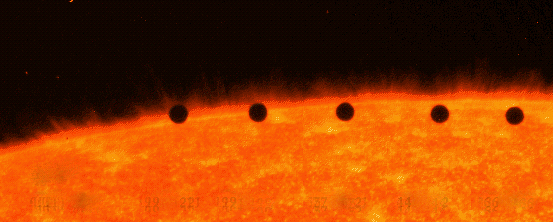Mercury's Transit of the Sun
Mercury is one of only two planets in the Solar System that can be observed passing in front of the surface of the Sun from Earth. The other planet is Venus. This is because both Mercury and Venus are positioned in between Earth and the Sun. All of the other planets are behind Earth in order from the Sun. The occurrence of a planet passing in front of the Sun is called a transit.

Although Mercury orbits the Sun every 88 days, it is actually quite rare for it to be seen passing in front of the Sun from Earth. When viewed from Earth, transits of Mercury happen about 13 times in each century. The Sun is huge, but when viewed from Earth it is relatively small in the sky. Mercury is smaller still, so lining up Mercury in front of the Sun doesn't happen very often. The most recent transits of Mercury across the Sun took place in November 2019, May 2016, November 2006, May 2003, November 1999 and November 1993. The next time Mercury will transit the Sun will be in November 2032 and will be visible from Africa, Europe and parts of Asia. If you're in North America, you'll need to wait until May 2049 for the next one. Notice a pattern? Transits of Mercury as viewed from Earth only happen in May or November!

Being able to get a shot of Mercury passing in front of the Sun isn't very easy. This is because the Sun is extremely bright and Mercury is very small in comparison.
However, with the right equipment and knowledge of when such an event is due to happen, it is possible to observe a Mercury transit. It's also a good opportunity to see
how tiny Mercury actually is when compared with the Sun.
Astronomers use telescopes with special filters to block out most of the Sun's light and safely observe the transit. It's
also possible to observe transits from space with fancy pants space telescopes and the miracles of modern technology.
When it is in front of the Sun, Mercury appears as a very small dark spot. In a May transit, Mercury appears to be about 1/158 the size of the Sun. This means that
the Sun appears 158 times wider than Mercury. In a November orbit, Mercury appears 1/194 the size of the Sun. It appears larger during a May transit than during a
November one due to the planet's eccentric (non-circular) orbit.
The existence of Mercury has been known since ancient times as it is easily observable from Earth either just after sunset or just before sunrise.
The first person to observe and record it passing in front of the Sun was Pierre Gassendi, a French astronomer and priest. He made his observations
on 7th November 1631.
Gassendi's observation of this transit wasn't by chance. In 1627, the German astronomer Johann Kepler predicted that Mercury would pass in front of the Sun in 1631.
Although Kepler died before he could observe it for himself, other astronomers made it their mission to see if they could see it. Gassendi was one of them and
he began looking out for it two days before it actually happened. The Sun's disc was projected through a small hole in a dark room and lined up with a circle that Gassendi
had drawn on a sheet. He would periodically stamp his feet so an assistant outside could give him details of the Sun's position in the sky.
Although cloud and rain nearly hampered Gassendi's chances of seeing the transit, he eventually noticed a small dark spot on the Sun's disc. At first, he thought it to be
a sunspot. Back then, nobody actually knew how large Mercury was and Gassendi expected it to be much bigger. By observing its rapid movement across the Sun, he knew he was looking
at a planet. This first observation of a transit of Mercury in front of the Sun was also the first time that Mercury's size could be determined.

The length of time for a transit of Mercury varies depending on the path it takes across the Sun. Sometimes it can travel almost the entire disc of the Sun by going across its middle, other times it travels closer to the Sun's edges so has a shorter distance to cover. A partial transit is when only part of Mercury goes in front of the Sun's disc. The last time this happened was on 11th May 1937 when the partial transit lasted 13 minutes. These kinds of transits are very rare. Full transits, which are when the whole of Mercury goes in front of the Sun, are much more common. They can last from anywhere between 1 hour up to almost 8 hours.

It's not just on Earth where Mercury's transits can be seen. They can also be observed over on Earth's rusty-coloured neighbour, Mars. Of course, no human being has ever set foot on Mars so the task of looking out for transits needs to be handled by space craft instead. The Curiosity rover is one such space craft and on 3rd June 2014, it sent back some rather impressive pictures of Mercury making its merry way across the face of the Sun. This was the first time that any planetary transit had been observed from any planet other than Earth.
Mercury's transits are visible from Mars much more frequently than from Earth. Approximately 13 transits are visible each century from Earth. Over on Mars, about 25 transits are visible.





